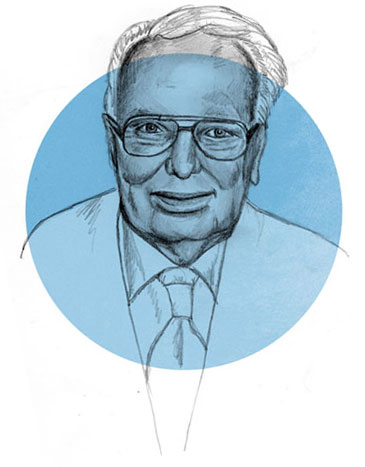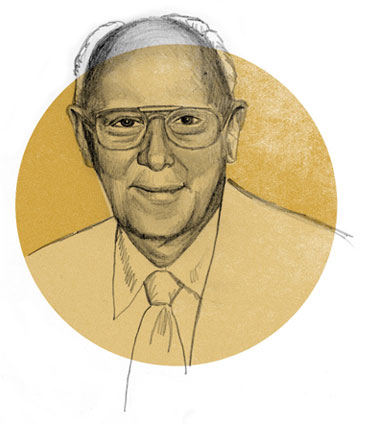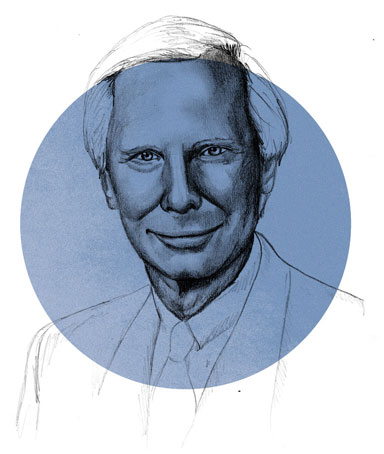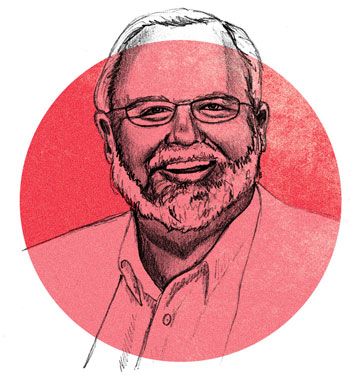Leaving a Legacy
The presidential fingerprint on our movement
By Dan Schaeffer // Portraits by Lindsay Gilmore
“The radiating influence from one person rightly related to God is incalculable; he may not say much, but you feel different.” — Oswald Chambers1
The legacy of any person or people is always what they have left behind. Not only their possessions and any long-term consequences of their actions, but also the way we feel toward them and how differently we act because of their presence in our lives.
We can track many influences on the EFCA movement, but none so pervasive or influential as those of the presidents whom God raised up to serve. We have the privilege of being able to still talk with three of them, and the fourth is not long out of our memory. Each man retains the passion and sense of calling that led him to his unique point in history—leadership of the Evangelical Free Church of America.
Dr. Arnold T. Olson
“Foundational”
For eight years, Arnold Olson had served as president of the Norwegian-Danish Evangelical Free Church Association. During merger conversations with the Swedish Evangelical Free Church Association in 1950, he took on chairmanship of the merger committee. Olson was then elected president of the new EFCA—his 25 years marking him as the longest-tenured president in the movement’s history2.
Olson’s impact was significant. “He shaped the initial culture of the denomination, not only by his speaking but also by his writings,” says the EFCA’s second president, Tom McDill, referring to Olson’s books as well as his oversight of the EFCA’s original Statement of Faith.
One challenge to Olson’s work was that many in the new EFCA were still attached to the culture of the past and, in fact, still spoke their native tongues while in church. Olson began moving the EFCA toward a more diversified representation of America.
That spirit of diversity would become pivotal to the essence of the fledgling movement, as would the president’s urging that members not become divided over minor issues of faith.
As a result, the theological and doctrinal tent pegs were set solidly and firmly around essential Christian doctrine. It was a major accomplishment to take two different groups and create a new, unified and healthy denomination.
“Dr. Olson put in a lot of the good DNA we have,” agrees Bill Hamel, the EFCA’s current president. “He shaped the culture and the movement.”
What many people don’t know, McDill adds, is that Olson was a chaplain in World War II. In 1947, he was called overseas in his chaplaincy role, taking a several-year leave of absence. Though his ship was torpedoed, Olson returned unharmed and continued to serve the church after the war.
Dr. Thomas A. McDill
“A bridge”
If Olson was foundational, recalls Hamel, “Dr. McDill was the one who put in a vision for church planting and church expansion. He really started what we call the ‘all-people movement,’ with his significant message at the EFCA centennial conference in 1984.” (Appropriately, it was a non-Scandinavian president whom God used to launch this.)
Hamel recalls sitting in that conference as a young pastor and listening to McDill give a call to reach America’s recent immigrants. The message resonated deep in Hamel’s soul, and he thought to himself, I can envision that. That is exciting.
Under McDill’s oversight, the EFCA also exploded in size, growing from 500 churches when he took office, to more than 1,100 when he left. At one point, the EFCA was planting or accepting a church every week.
Growth happened in other ways as well. McDill saw early on that the EFCA needed some good old-fashioned organizational updating. In early 1977, for example, after a day of training from IBM, he returned to introduce the first mainframe computer system, which streamlined receipt processing. McDill also hired the movement’s first director of business affairs.
“As I look back,” McDill says, “I was a bridge from what the Evangelical Free Church had been to what it was becoming.”
Dr. Paul A. Cedar
“Passionate spirituality”
Creating a foundation and a passion for growth were integral to the EFCA’s spiritual DNA, yet they weren’t the only essentials for building a healthy movement. While recognizing the EFCA’s strong emphasis on the teaching of the Word, Paul Cedar was concerned that the movement needed to be stronger in the areas of prayer, evangelism and dependence upon the Holy Spirit.
In each of those areas, McDill affirms that Cedar “pushed the Evangelical Free Church a notch higher.”
Under Cedar’s leadership, the EFCA hired its first full-time national director of prayer and launched an award-winning magazine called Pursuit, as a tool for evangelism. Cedar’s impact on the movement’s current president was also pronounced.
“He came in at a time when we needed to be a denomination of Spirit-led churches with a people who were devoted to passionate spirituality and prayer,” Hamel says. “We talked a lot about that—he was a great influence on my life.”
Dr. William J. Hamel
“All people”
In the early years of Bill Hamel’s leadership, the EFCA honed its mission focus: glorifying God by multiplying healthy churches among all people.
With his emphasis on “all people,” Hamel opened more conversations about ethnic, socioeconomic and gender diversity. And during his presidency, he formed a Biblical Diversity Task Force—with Caucasians in the minority—that helped him form a strategy to be more inclusive.
Hamel insisted, too, that the movement’s upper leadership itself should begin to reflect that desired diversity. The EFCA bylaws were changed to encourage diversity on the board of directors, and hiring practices were changed so as to broaden the pool of applicants for each position. Under Hamel, Immigrant Hope was launched as a natural extension of his all-people passion.
“The thing I’m most pleased with,” Hamel says,” is the fresh emphasis and openness in our churches to not only being multiethnic/multicultural, but also being externally focused”— taking Christ outside the walls of the church to the points of greatest human need.
Even with these emphases, Hamel’s commitment to the movement’s solid doctrinal and theological roots has never waivered. It is most evident in his courageous initiative to review the 58-year-old Statement of Faith. “What started out as a process of [review], with some minor modifications,” Cedar clarifies, “turned out to be a major rewrite with deeply theological, biblical thought and investment of time and focus.”
At the end of the five-year-long process, the Statement of Faith was not narrowed, nor weakened, but strengthened.
The accomplishments to date are only a taste of what Dr. Hamel will bring to the EFCA in the future.
Living legacy
The values of the EFCA were conveyed by each successive president and embodied by each—articulating the primary mission of the EFCA in new ways and with new words, and in changing cultures and contexts.
And while they unquestionably shaped the movement, the act of leading the EFCA also shaped them.
From the movement that the Holy Spirit has spawned, and that these leaders have helped keep alive and healthy, will come the next generation of leaders. Thus, our legacy is not a historical relic but a living presence.
1 Draper’s Book of Quotations for the Christian World, Edythe Draper (Tyndale House Publishers, Inc, Wheaton, Illinois, 1992).
2 Before Arnold T. Olson stepped in as the EFCA’s first official president, another distinguished leader served for a year in an interim capacity: Dr. E.A. Halleen. His interim position followed his 1922-1950 role as president of the Swedish Evangelical Free Church Association.
Dan Schaeffer is a published author and pastor of Shoreline Community Church (EFCA) in Santa Barbara, Calif. As pastor of a multicultural church reaching the Hispanic community, Dan is experiencing firsthand the fruits of the all-people movement.
Leaving a Legacy
The legacy of any person or people is always what they have left behind. Not only their possessions and any long-term consequences of their actions, but also the way we feel toward them and how differently we act because of their presence in our lives.
We can track many influences on the EFCA movement, but none so pervasive or influential as those of the presidents whom God raised up to serve. We have the privilege of being able to still talk with three of them, and the fourth is not long out of our memory. Each man retains the passion and sense of calling that led him to his unique point in history—leadership of the Evangelical Free Church of America.
Dr. Arnold T. Olson
1951-1976 “FOUNDATIONAL”
FOR EIGHT YEARS, Arnold Olson had served as president of the Norwegian-Danish Evangelical Free Church Association. During merger conversations with the Swedish Evangelical Free Church Association in 1950, he took on chairmanship of the merger committee. Olson was then elected president of the new EFCA—his 25 years marking him as the longest-tenured president in the movement’s history2.
Olson’s impact was significant. “He shaped the initial culture of the denomination, not only by his speaking but also by his writings,” says the EFCA’s second president, Tom McDill, referring to Olson’s books as well as his oversight of the EFCA’s original Statement of Faith.
One challenge to Olson’s work was that many in the new EFCA were still attached to the culture of the past and, in fact, still spoke their native tongues while in church. Olson began moving the EFCA toward a more diversified representation of America.
That spirit of diversity would become pivotal to the essence of the fledgling movement, as would the president’s urging that members not become divided over minor issues of faith.
As a result, the theological and doctrinal tent pegs were set solidly and firmly around essential Christian doctrine. It was a major accomplishment to take two different groups and create a new, unified and healthy denomination.
“Dr. Olson put in a lot of the good DNA we have,” agrees Bill Hamel, the EFCA’s current president. “He shaped the culture and the movement.”
What many people don’t know, McDill adds, is that Olson was a chaplain in World War II. In 1947, he was called overseas in his chaplaincy role, taking a several-year leave of absence. Though his ship was torpedoed, Olson returned unharmed and continued to serve the church after the war.
Dr. Thomas A. McDill
1976-1990 “A BRIDGE”
IF OLSON WAS FOUNDATIONAL, recalls Hamel, “Dr. McDill was the one who put in a vision for church planting and church expansion. He really started what we call the ‘all-people movement,’ with his significant message at the EFCA centennial conference in 1984.” (Appropriately, it was a non-Scandinavian president whom God used to launch this.)
Hamel recalls sitting in that conference as a young pastor and listening to McDill give a call to reach America’s recent immigrants. The message resonated deep in Hamel’s soul, and he thought to himself, I can envision that. That is exciting.
Under McDill’s oversight, the EFCA also exploded in size, growing from 500 churches when he took office, to more than 1,100 when he left. At one point, the EFCA was planting or accepting a church every week.
Growth happened in other ways as well. McDill saw early on that the EFCA needed some good old-fashioned organizational updating. In early 1977, for example, after a day of training from IBM, he returned to introduce the first mainframe computer system, which streamlined receipt processing. McDill also hired the movement’s first director of business affairs.
“As I look back,” McDill says, “I was a bridge from what the Evangelical Free Church had been to what it was becoming.”
Dr. Paul A. Cedar
1990-1996 “PASSIONATE SPIRITUALITY”
CREATING A FOUNDATION and a passion for growth were integral to the EFCA’s spiritual DNA, yet they weren’t the only essentials for building a healthy movement. While recognizing the EFCA’s strong emphasis on the teaching of the Word, Paul Cedar was concerned that the movement needed to be stronger in the areas of prayer, evangelism and dependence upon the Holy Spirit.
In each of those areas, McDill affirms that Cedar “pushed the Evangelical Free Church a notch higher.”
Under Cedar’s leadership, the EFCA hired its first full-time national director of prayer and launched an award-winning magazine called Pursuit, as a tool for evangelism. Cedar’s impact on the movement’s current president was also pronounced.
“He came in at a time when we needed to be a denomination of Spirit-led churches with a people who were devoted to passionate spirituality and prayer,” Hamel says. “We talked a lot about that—he was a great influence on my life.”
Dr. William J. Hamel
1997-present “ALL PEOPLE”
IN THE EARLY YEARS of Bill Hamel’s leadership, the EFCA honed its mission focus: glorifying God by multiplying healthy churches among all people.
With his emphasis on “all people,” Hamel opened more conversations about ethnic, socioeconomic and gender diversity. And during his presidency, he formed a Biblical Diversity Task Force—with Caucasians in the minority—that helped him form a strategy to be more inclusive.
Hamel insisted, too, that the movement’s upper leadership itself should begin to reflect that desired diversity. The EFCA bylaws were changed to encourage diversity on the board of directors, and hiring practices were changed so as to broaden the pool of applicants for each position. Under Hamel, Immigrant Hope was launched as a natural extension of his all-people passion.
“The thing I’m most pleased with,” Hamel says,” is the fresh emphasis and openness in our churches to not only being multiethnic/multicultural, but also being externally focused”— taking Christ outside the walls of the church to the points of greatest human need.
Even with these emphases, Hamel’s commitment to the movement’s solid doctrinal and theological roots has never waivered. It is most evident in his courageous initiative to review the 58-year-old Statement of Faith. “What started out as a process of [review], with some minor modifications,” Cedar clarifies, “turned out to be a major rewrite with deeply theological, biblical thought and investment of time and focus.”
At the end of the five-year-long process, the Statement of Faith was not narrowed, nor weakened, but strengthened.
The accomplishments to date are only a taste of what Dr. Hamel will bring to the EFCA in the future.
Living legacy
The values of the EFCA were conveyed by each successive president and embodied by each—articulating the primary mission of the EFCA in new ways and with new words, and in changing cultures and contexts.
And while they unquestionably shaped the movement, the act of leading the EFCA also shaped them.
From the movement that the Holy Spirit has spawned, and that these leaders have helped keep alive and healthy, will come the next generation of leaders. Thus, our legacy is not a historical relic but a living presence.
- Draper’s Book of Quotations for the Christian World, Edythe Draper (Tyndale House Publishers, Inc, Wheaton, Illinois, 1992).
- Before Arnold T. Olson stepped in as the EFCA’s first official president, another distinguished leader served for a year in an interim capacity: Dr. E.A. Halleen. His interim position followed his 1922-1950 role as president of the Swedish Evangelical Free Church Association.
Dan Schaeffer is a published author and pastor of Shoreline Community Church (EFCA) in Santa Barbara, Calif. As pastor of a multicultural church reaching the Hispanic community, Dan is experiencing firsthand the fruits of the all-people movement.



